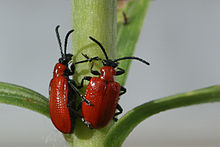Leaf beetles
| Leaf beetles | |
|---|---|
 |
|
| Scarlet lily beetle Lilioceris lilii in Oxfordshire, UK | |
| Scientific classification | |
| Kingdom: | Animalia |
| Phylum: | Arthropoda |
| Class: | Insecta |
| Order: | Coleoptera |
| Superfamily: | Chrysomeloidea |
| Family: |
Chrysomelidae Latreille, 1802 |
| Subfamilies | |
|
See text |
|
See text
The family Chrysomelidae, commonly known as leaf beetles, includes over 37,000 (and probably at least 50,000) species in more than 2,500 genera, making it one of the largest and most commonly encountered of all beetle families. Numerous subfamilies are recognized, but only some of them are listed below and the precise taxonomy and systematics are likely to change with ongoing research.
Leaf beetles are partially recognizable by their tarsal formula, which appears to be 4-4-4, but is actually 5-5-5 as the 4th tarsal segment is very small and hidden by the 3rd. As with many taxa, there is no single character that defines the Chrysomelidae; instead it is delineated by a set of characters. Some lineages are only distinguished with difficulty from longhorn beetles (family Cerambycidae), namely by the antennae not arising from frontal tubercles.
Adult and larval leaf beetles feed on all sorts of plant tissue, and all species are fully herbivorous. Many are serious pests of cultivated plants, for example the Colorado potato beetle (Leptinotarsa decemlineata), the asparagus beetle (Crioceris asparagi), the cereal leaf beetle (Oulema melanopus), and various flea beetles, and a few act as vectors of plant diseases. Others are beneficial due to their use in biocontrol of invasive weeds. Some Chrysomelidae are conspicuously colored, typically in glossy yellow to red or metallic blue-green hues, and some (especially Cassidinae) have spectacularly bizarre shapes. Thus, they are highly popular among insect collectors.
...
Wikipedia
